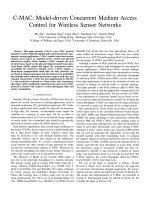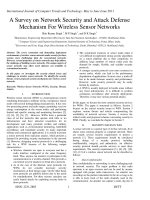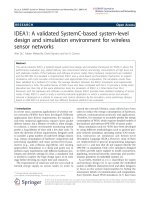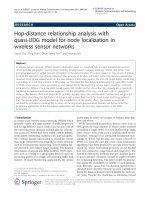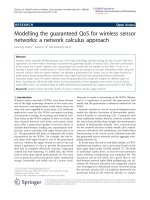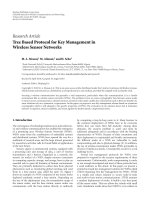A prioritized MAC protocol for multihop, event driven wireless sensor network
Bạn đang xem bản rút gọn của tài liệu. Xem và tải ngay bản đầy đủ của tài liệu tại đây (7.74 MB, 94 trang )
A PRIORITIZED MAC PROTOCOL FOR MULTIHOP,
EVENT-DRIVEN WIRELESS SENSOR NETWORK
NGUYEN TRUNG KIEN
NATIONAL UNIVERSITY OF SINGAPORE
2006
A PRIORITIZED MAC PROTOCOL FOR MULTIHOP,
EVENT-DRIVEN WIRELESS SENSOR NETWORK
NGUYEN TRUNG KIEN
(B.Eng. Hons.)
(Hanoi University of Technology, Vietnam)
A THESIS SUBMITTED
FOR THE DEGREE OF MASTER OF ENGINEERING
DEPARTMENT OF ELECTRICAL AND COMPUTER ENGINEERING
NATIONAL UNIVERSITY OF SINGAPORE
2006
- i -
Acknowledgements
I would like to express my sincere thanks to my main supervisor, A/P Chua
Kee Chaing, for his valuable support. I am very grateful for his constant guidance
and encouragement. I thank him for the time he has spent with me, reading,
discussing and critiquing my work. I would like to thank Dr. Mehul Motani, my co-
supervisor. His advice and feedback about my research have greatly enhanced and
strengthened the work. I thank him for all the time and energy he has invested into
my research.
I am indebted to my parents, for everything they have given to me. They taught
me the value of knowledge, the joy of love and the importance of family. They have
stood by me in everything I have done, providing constant support, encouragement,
and love. I would like to thank my two sisters and my wife for their endless love and
support. I am very happy to have such a wonderful family members.
Finally, I am grateful to NUS for giving me financial support. Without it I
would not have done this work.
- ii -
To my beloved family
To whom I have learned
- iii -
Table of Contents
Acknowledgements i
Dedication ii
Table of contents iii
Summary vi
List of tables ix
List of figures x
Chapter 1. Introduction 1
1.1 Wireless sensor networks 1
1.1.1 Event-driven wireless sensor networks 4
1.1.2 Multihop communication pattern 6
1.2 Motivation 8
1.3 Problem statement and proposed solutions 9
1.4 Key contributions 11
1.5 Outline of the thesis 11
Chaper 2. Review of MAC protocol for wireless sensor networks 13
2.1 Background 13
2.1.1 Why existing MAC can not be used in wireless sensor networks? 14
- iv -
2.2 IEEE 802.11 Standard 15
2.3 Energy efficient MAC protocols for wireless sensor networks 18
2.3.1 Energy Conservation Principles 18
2.3.2 Sensor-MAC protocol 19
2.3.3 Timeout-MAC protocol 22
2.3.4 Energy and Rate based MAC protocol [31] 23
2.3.5 Traffic-Adaptive MAC Protocol (TRAMA) 24
2.3.6 Data-gathering MAC protocol 25
2.4 SIFT – A low latency MAC protocol for event-driven wireless sensor
networks 27
2.4.1 SIFT design 27
2.4.2 Simulation results 29
2.4.3 Problem of SIFT and our proposed protocol - PSIFT 36
Chapter 3. PSIFT – A Prioritized MAC Protocol for Multihop, Event-driven
Wireless Sensor Networks 38
3.1 PSIFT design 38
3.2 PSIFT description 41
3.2.1 RTS/CTS hand-shaking 43
3.2.2 Suppressing reports using acknowledgement (explicit ACK) 44
3.3 Simulation results and analysis 46
3.3.1 Simulation topology 47
3.3.2 Simulation details 48
3.3.3 Latency experiments 49
3.3.4 Throughput experiment 60
3.3.5 Summary 63
- v -
Chapter 4. PSIFT with overhearing mechanism 64
4.1 Suppression using overhearing (implicit ACK) 65
4.2 Simulation results and analysis 67
Chapter 5. Conclusions and future work 72
5.1 Conclusions 72
5.2 Future work 73
References 74
- vi -
Summary
Wireless sensor networks are characterized by large number of devices,
unattended deployment, energy constraints, common device failures, frequent
configuration changes, and a significant range of task dynamics. In which, many
sensor networks are event-driven. Event-driven sensor networks operate under an
idle or light load and then suddenly become active in response to an interested event.
The transport of event report is likely to lead to varying degrees of congestion in the
network depending on the sensing application. It is during these periods of event
happen that the likelihood of congestion is greatest and the information in transit of
most importance to users. In additions, the reports generated by different nodes in
vicinity of event position are correlated. That is why not all the sensor nodes need to
send their report, only a few of them is enough for the sink to identify the event.
Exploiting the node redundancy in dense wireless sensor network can improve its
delay performance.
Furthermore, a sensor network is typically composed of a large number of
small-size, low-cost, low power sensor nodes which are randomly deployed and
communicated with one another to send data to the sink. Because of limited
- vii -
capability of sensor node, the report packet can only be broadcast to the neighboring
nodes, which then further relay the packet to its neighbor in the direction to the sink
(controlled by routing protocol). Traversing hop by hop, the report finally reaches the
sink to be analyzed and taken further action as required by the application. In this
multihop transmission scenario, data packet that traverses through longer route
(through higher number of hops) is more important than the packet with shorter
route. Then the relay node must treat them differently according to their importance
level. In other word, the route-through traffic is more important than the originated
traffic.
In this thesis, we propose a new Prioritized medium access control protocol
(PSIFT) that utilized the redundancy characteristics of sensor nodes in event-driven
wireless sensor networks. In which many sensor nodes in vicinity sense the same
event and contend to transmit report about it. However, not all these reports are
required by the sink to identify the event. By suppressing unnecessary reports on the
same event, PSIFT lowers the offer load of the network, which results in low
collision probability and improvement in delay performance of the network. PSIFT is
a CSMA-based MAC protocol, using fixed-size contention window with a
geographically increasing probability distribution of selecting transmission slot
within the window. Furthermore, to provide services compatible with the packet
priority levels which increases each time packet travel one more hop, PSIFT uses
different DCF inter frame space (DIFS) and contention window size (CW) for each
traffic class. PSIFT can differentiate service to each packet since the priority
information is packed into the packet. We also proposed the new report suppression
mechanism based on the broadcast nature of wireless transmission. This mechanism
works very efficiently in large-scale, event-driven wireless sensor network.
- viii -
The simulation results show that the new PSIFT MAC protocol can bring
significant improvement in delay performance of the network. When the sensing
range grow up to transmission range, PSIFT gains up to 3-times latency reduction in
delivering reports compared to the existing IEEE802.11 MAC protocol, while
maintaining the correctness in reporting event.
- ix -
List of Tables
Table 3.1 Detail implementation of PSIFT 42
Table 3.2 Simulation parameters 49
- x -
List of Figures
Figure 1.1 Components of a sensor node 2
Figure 1.2 Sensor nodes scattered in a sensor field 5
Figure 2.1 IEEE 802.11 access scheme 16
Figure 2.2 A data gathering tree with staggered DMAC slots 26
Figure 2.3 Packet delivery ratio as a function of per-sender CBR traffic rate 31
Figure 2.4 Average delay as a function of the number of sensors activated to report
an event 32
Figure 2.5 Average delay as a function of the number of event reports required 33
Figure 2.6 Fairness comparison 35
Figure 3.1 Priority level of data packet 40
Figure 3.2 Assigning different DIFS values to each priority class 41
Figure 3.3 Max 4 priority levels and their distribution 42
Figure 3.4 Hidden node problem 43
Figure 3.5 Exposed node problem 44
Figure 3.6 Report suppression mechanism using acknowledgement packets 45
Figure 3.7 Random routing tree of 64 nodes 48
Figure 3.8 Average delay when 1 report is required 51
- xi -
Figure 3.9 Average delay with the sensing range of 45m 52
Figure 3.10 Average delay as a function of the number of attempted reports and 1
report is required 53
Figure 3.11 Average delay as a function of the number of reports required when 32
nodes send report 53
Figure 3.12 Average delay as a function of the maximum variation of the time that
each sensor reports the event 55
Figure 3.13a. Average hop-by-hop delay as a function of the sensing range and 1
report required 57
Figure 3.13b. Average delay of first hop only 58
Figure 3.13c. Average delay when sensing range is 30m 58
Figure 3.14 Delay distribution at the sink with sensing range of 30m 59
Figure 3.15 Offer load and overhead comparison 60
Figure 3.16 Packet delivery ratio as a function of the number of CBR sources 61
Figure 3.17 Average delay as a function of the number of CBR sources 62
Figure 4.1 Overhearing mechanism 66
Figure 4.2 Average end-to-end delay in real adhoc routing scenario(AODV) when
one report required 68
Figure 4.3 Delay distribution at the sink as a function of the sensing ranges of two
suppression mechanisms with one report required 70
- 1 -
Chapter 1
1 Introduction
1.1 Wireless sensor networks
Recent improvements in wireless communications and hardware technology
have enabled the development of small-size, low-cost, low power sensor nodes.
These nodes typically consist of the following components as seen in Figure 1.1:
• Processing unit: is generally associated with a small storage unit,
manages the procedures that make the sensor node collaborate with the
other nodes to carry out the assigned sensing tasks.
• Sensing unit: is usually composed of sensors and analog-to-digital
converters (ADC). The analog signals produced by the sensors based on
the observed phenomenon are converted to digital signals by the ADC,
and then fed into the processing unit.
• Transceiver unit: to connects the node to the network.
• Power unit: may be supported by power scavenging units to provide
energy for the whole sensor node.
- 2 -
Apart from the above mentioned units, sensor node may also have other
components such as location finding systems and supplemental power sources like
solar cells etc., based on the area of deployment and the particular application
needed.
Figure 1.1 Components of a sensor node
The above described features of sensor nodes enable the deployment of dense
networks with a large number of sensor nodes in which each sensor is self-sustained,
independent entity to perform a large sensing task. Small-size sensor can only be
equipped with limited battery power and an omni-directional antenna, thus each
sensor is only capable of short transmission range. A network of these nodes can be
changing dynamically yet still maintaining robust communication connectivity and
commonly referred to as Wireless Sensor Networks. This particular aspect of
distributed networks has been the subject of extensive research with a wide range of
applications. Researchers are contemplating their widespread deployment in
challenging scenarios where wired networks are infeasible or impractical.
A distributed network of wireless sensors enables the reliable monitoring and
control of a variety of applications that range from medical and home security to
machine diagnosis, chemical/biological detection and other military applications. For
example, military application sensor networks such as combat field surveillance and
security could bring safety to the troops. Such a network of sensors could be
Transceiver ADC
Processor
Storage
Sensor
Processing
unit
Sensing unit
Power unit
- 3 -
deployed in combat scenarios to track troop movements. Sensors placed on small
robots could conduct landmine detection. Smart sensors could detect the use of
biological or chemical weapons and, then report their presence in time via
communication network to protect troops. Besides military usage, many useful and
varied applications of sensor networks are also being developed for our everyday
lives. Biomedical sensors are being developed for a retinal prosthesis to aid the
visually impaired. Sensors are used to analyze the motion of a tornado. Sensors are
deployed in a forest for fire detection. Sensors are attached to taxi cabs in a large
metropolitan area to study the traffic conditions and plan routes effectively. Clearly,
there is a wide range of applications for sensor networks with differing requirements.
Realization of these and other sensor network applications require the
development of new networking techniques. Although many protocols and
algorithms have been proposed for traditional wireless ad-hoc networks, they are not
well suited to the unique features and application requirements of sensor networks.
To illustrate this point, the differences between sensor networks and traditional
wireless ad-hoc networks are:
• The number of sensor nodes in a sensor network can be several orders
of magnitude higher than the nodes in an ad hoc network.
• Sensor nodes are densely deployed.
• Sensor nodes are prone to failures.
• The topology of a sensor network changes very frequently.
• Sensor nodes mainly use a broadcast communication paradigm,
whereas most ad hoc networks are based on point-to-point
communications.
- 4 -
• Sensor nodes are limited in power, computational capacities, and
memory.
• Sensor nodes may not have global identification (ID) because of the
large amount of overhead and large number of sensors.
Many researchers are currently engaged in developing schemes that fulfill
these requirements.
1.1.1 Event-driven wireless sensor networks
Wireless sensor network is assumed to be a homogeneous network. It consists
of multiple sensor nodes and a sink. The sink can be either mobile or stationary. It
serves as the client or end-user from which the user controls the wireless sensor
network. The sink can be used to request information from the sensor network. The
sink then receives information from the sensor nodes and processes the obtained
information. It performs local data aggregation within the wireless sensor network.
A typical use of wireless sensor networks is to have a kind of streaming data, in
which little amounts of data (typically just a few bytes) are transmitted periodically
(for example in temperature measurement system). The large number of nodes will
allow taking advantage of short-range, multi-hop communication to conserve energy,
especially when data aggregation is applied.
Another typical scenario of wireless sensor networks, on which the current
research is based, is event-driven applications. The wireless sensor network is
designed to detect events and propagate the information back to the sink. The
network can also be designed in such a manner that the sink ascertains information
about the events in a particular region of the network. In event-driven wireless sensor
- 5 -
network, individual sensor node is in a dormant state for long periods, and suddenly
become active when an event happened. Such applications (for example: surveillance
application) will thus have long idle periods and can tolerate some latency in network
setup. With this type of application, when detecting an event of interest, the sensor
nodes collects the relevant information associated with this event into a report
packet, then transmit it to the command center (the sink). Because of the limited
capability of sensor nodes, the report packet can only be broadcast to the neighboring
nodes, which then further relay the packet to their neighbor in the direction to the
sink (controlled by routing protocol). Traversing hop by hop, the reports finally reach
the sink to be analyzed and taken further action as required by the application (shown
in Figure 1.2).
Figure 1.2 Sensor nodes scattered in a sensor field
Let’s consider the sensor field with the only sink as describing in Figure 1.2.
Sensor nodes are randomly deployed over the flat terrain to track the presence of an
interested event. Each of these scattered sensor nodes has the capabilities to collect
A
B
C
D
Sink
Sensor field
Sensor nodes
Event
- 6 -
data and route data back to the sink. Data are routed back to the sink by a multihop
architecture through the sink as follow:
When an event happens, all the sensors located in the vicinity can sense this
event and contend for medium to forward their reports to the sink. The number of
contenders is depended on the sensing range of the sensor node. Suppose sensor A
wins the medium and broadcasts its report to all of its one-hop neighbors. Out of
them, sensor B successfully receives the report first then it forwards the reports
toward the sink. Similarly, sensor C, one of the one-hop neighbors of sensor B, is the
next relay node in the transmission route. Finally, the event report has to traverse
through 4-hops from A→B→C→D→Sink. This transmission route is determined by
the routing algorithm, and may be different for each event. The design of the sensor
network as described by Figure 1.2 is influenced by many factors, including fault
tolerance, scalability, production costs, operating environment, sensor network
topology, hardware constraints, transmission media, and power consumption.
1.1.2 Multihop communication pattern
Sensor nodes are most valued for their small size and low signal processing
capabilities. Sensor nodes have usually been deployed in situations where the
communicating sensor nodes are not within radio coverage. Intermediate sensor
nodes perform routing functions to enable range extension between the
communicating nodes.
Due to low antenna height, ground level features have a strong effect on
propagation loss. Small rocks, plants, or even mild undulation in the terrain can
create significant variations in the radio channel characteristics. They may result in a
drastic drop in signal strength. In the network with obstacles in the line of sight
- 7 -
between the source and the receiver, multihop communication patterns can be helpful
in ensuring access to all areas of the network.
In addition, while dealing with an unreliable, high bit-error-rate channel like
the wireless medium, there are some special communication considerations which
should be taken into account. One way of ensuring more reliable and efficient
communication in these channels is through the use of multihop communication.
Multihop communication facilitates the reuse of resources in both spatial and
temporal domains, provided that the nodes which participate in the network are
reasonably well distributed in space. In contrast, single-hop networks mainly share
the channel resources in the temporal domain only. This sharing of channel resources
enables the multihop network to provide greater spectral efficiencies, resulting in
better bandwidth utilization.
Multihop communication also enables us to derive maximal energy savings in
the network by controlling the transmission power and limiting the broadcast over a
short distance.
The power received, P
R
, at a receiving antenna with a gain
R
G at the distance d
from the transmit antenna with gain
T
G is:
RTT
TT
R
GPG
d
A
d
GP
P
2
2
2
)4(4
π
λ
π
==
Where: A is the effective area or aperture of the antenna,
2
4
λ
π
A
G
R
=
, and the
wavelength
c
f
c
=
λ
where c is the velocity of light and f
c
is the carrier
frequency.
- 8 -
The equation shows that the minimum received power for a given signal to
noise ratio is inversely proportional to the square of the distance between the sender
and the receiver. For a given transmit power P
T
, the received power P
R
will decrease
by an order of 4 if the distance between the sender and the receiver increases by an
order of 2. Thus a transmission over a short hop distance is more energy conserving
than a direct communication between two end points in the network. This may
results in longer network lifetime.
Another direct benefit of controlling power over a short range is that it can
reduce the total interference level in a homogeneous multihop network with multiple
communicating nodes and fixed traffic. This lesser interference can result in higher
throughput and improved Quality of Service (QoS) in the network.
In summary, multihop communication in wireless sensor networks is beneficial
since it:
• Conserves energy resources and increases the network lifetime.
• Reduces interference.
• Increases overall network throughput.
• Allows access to all areas of the network.
These characteristics bring many challenges in managing the share wireless
medium of dense wireless sensor network.
1.2 Motivation
Many sensor networks are event-driven. Event-driven sensor networks operate
under an idle or light load and then suddenly become active in response to an event.
- 9 -
The transport of the event reports are likely to lead to varying degrees of congestion
in the network depending on the sensing application. It is during these periods of
event happen that the likelihood of congestion is greatest and the information in
transit of most importance to users. Usually, the reports generated by different nodes
in the vicinity of an event are correlated. Therefore, not all the sensor nodes need to
send their own report, indeed, only a few of them are enough for the sink to identify
the event. Exploiting the node redundancy in dense wireless sensor network can
improve its delay performance. By suppressing unnecessary report, we reduce the
congestion level of the network and achieve energy savings as well.
Furthermore, a sensor network is typically composed of a large number of
sensor nodes which are randomly deployed and communicated with one another to
send data to the sink. In this multihop transmission scenario, data packets that
traverse through longer route (means through higher number of hops) are more
important than the packet with shorter route. Then the relay node must treat them
differently according to their importance level. In other word, the route-through
traffic is more important than the originated traffic. However, existing MAC
protocols treat all packets indifferently, that may lead to the degradation in delay
performance and quality of service of the network. Therefore, it is a need to develop
a MAC protocol that can handle this type of traffic load under this specific network
scenario.
1.3 Problem statement and proposed solutions
Our goal is to develop a new MAC protocol that can minimize the time taken
in delivering the first few required event reports in multihop, event-driven wireless
- 10 -
sensor networks. Being a CSMA-based MAC protocol, the first few successful slots
in our protocol should be contention-free. Our protocol adopts the solution proposed
in SIFT [33]: using fixed size contention window and an increasing probability
distribution for picking a transmission slot within the window. The main issues that
our protocol addresses are as follows:
• In multihop transmission, the relay nodes have to route different data
flows which have different priority levels. This may degrade the quality
of service given to each data flow because of the random characteristics
of CSMA-based MAC protocol. We propose a scheme for the assign
different DCF inter frame space (DIFS, time needed to ensure that the
wireless medium is idle) and contention window size (CW) to different
data packet. This ensures that higher priority data packet will be
transmitted earlier than the lower priority ones.
• With redundant sensor network, the earlier in doing report suppression
the better in delay performance. However, the suppression mechanism
using explicit acknowledgement has usually done in later hop and result
in higher delay. We present a new suppression mechanism using
implicit acknowledgement (through overhearing, based on the
broadcast nature of wireless communications) that can suppress almost
all unnecessary reports at the first hop. This mechanism brings
significant improvement to the delay performance of sensor network.
We created several simulation topologies and studied the effects of different
number of required reports by the application, sensing range and with or without
using real adhoc routing on the delay performance of sensor network. From the
simulation results we have shown that our proposed prioritized MAC protocol for
- 11 -
multihop, event-driven wireless sensor network effectively reduces the latency in
delivering the first report by 3 times when the node’s sensing range is equal to its
transmission range.
1.4 Key contributions
The main contributions of this thesis are as follows:
• We introduce the priority level of packet based on how many hops it
traversed. The higher number of hop, the higher level of priority that
packet has. Then we packed the priority information to the packet
header so that the following relay nodes can read and treat them
differently.
• We propose the different DCF inter frame space (DIFS) and contention
window size (CW) to each traffic class. This help sensor nodes
differentiate services to each packet according to its priority level.
• We proposed the new report suppression mechanism based on the
broadcast nature of wireless transmission. This mechanism work very
efficiently in large-scale, event-driven wireless sensor network.
1.5 Outline of the thesis
In the present work, we focus on developing a new PSIFT MAC protocol to
achieve low latency in delivering event report. The rest of this thesis is organized as
follows. Chapter 2 introduces the fundamentals of MAC protocol for wireless sensor
networks. We also reviews the various proposed MAC protocol for wireless sensor
- 12 -
networks in this chapter. Next, we present the detail design and characteristics of
PSIFT in chapter 3. Chapter 3 also presents the performance analysis of the proposed
PSIFT protocol. Then we introduce the new suppressing mechanism using
overhearing and study the performance of PSIFT with this overhearing mechanism in
chapter 4. Finally, we conclude this thesis with a summary and ideas for future
research in chapter 5.
